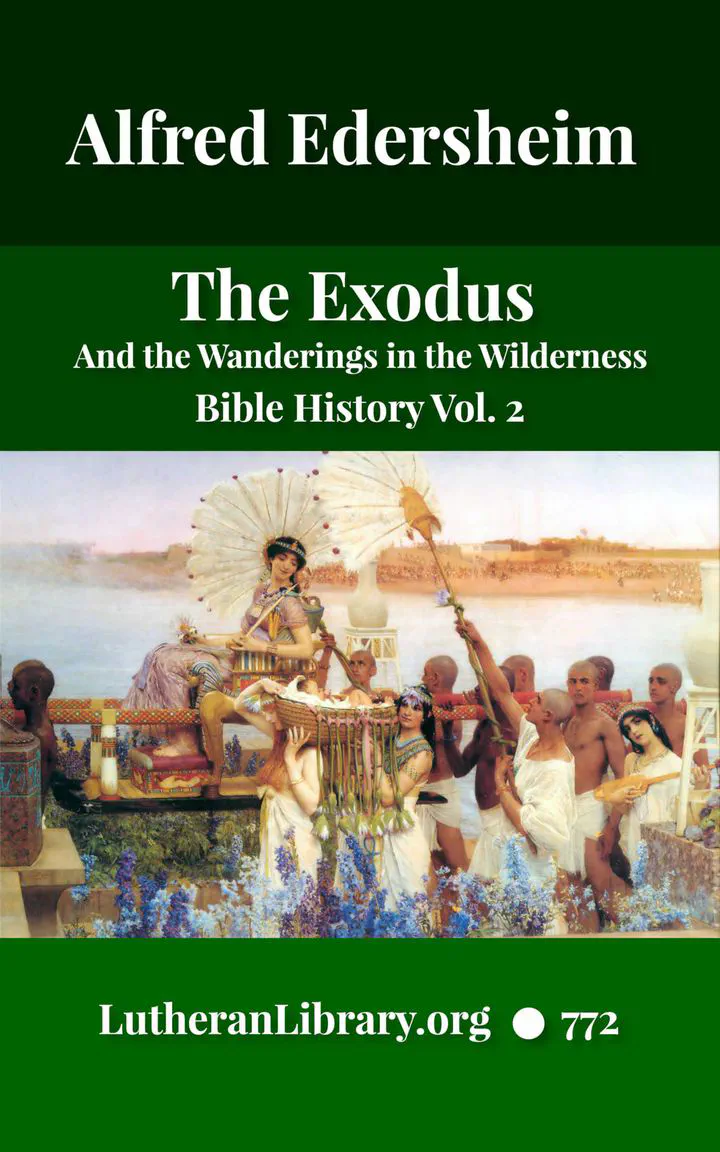The Exodus and the Wanderings in the Wilderness. Volume 2 of Bible History. by Alfred Edersheim

“It need scarcely be said, that in studying this narrative the open Bible should always be at hand. But I may remind myself and others, that the only real understanding of any portion of Holy Scripture is that conveyed to the heart by the Spirit of God. And, indeed, throughout, my great object has been, not to supersede the constant and prayerful use of the Bible itself, but rather to lead to those Scriptures, which alone “are able to make wise unto salvation through faith which is in Christ Jesus.” — Alfred Edersheim
Alfred Edersheim (1825-1889), was raised Jewish. He studied at the University of Vienna and New College, Edinburgh. After finding faith in the Messiah, he was ordained in the Free Church of Scotland, and later the Church of England. His books continue to be highly influential in bringing to life the background and details of the Old Testament historical accounts. His “Church History” series is especially intended for students, young people, and anyone who desires to deepen their understanding of the Bible.
Level of Difficulty: Primer: No subject matter knowledge needed.
Book Contents
Preface
The Exodus
- 1 Egypt and its History During the Stay of the Children of Israel, As Illustrated by the Bible and Ancient Monuments. (Exodus 1:1-7)
- 2 The Children of Israel in Egypt — Their Residences, Occupations, Social Arrangements, Constitution, and Religion — “A new King who knew not Joseph.” (Exodus 1 to end.)
- 3 The Birth, and the Training of Moses, both in Egypt and in Midian, as Preparatory to his Calling.
- 4 The Call of Moses — The Vision of the Burning Bush — The Commission to Pharaoh and to Israel — The three “Signs,” and their Meaning. (Exodus 2:23; 4:17.)
- 5 Moses Returns into Egypt — The Dismissal of Zipporah — Moses meets Aaron — Their Reception by the Children of Israel — Remarks on the Hardening of Pharaoh’s Heart. (Exodus 4:17-31.)
- 6 Moses and Aaron deliver their Message to Pharaoh — Increased Oppression of Israel — Discouragement of Moses — Aaron shows a Sign — General View and Analysis of each of the Ten “Strokes,” or Plagues. (Exodus 5-12:30.)
- 7 The Passover and its Ordinances — The Children of Israel leave Egypt — Their First Resting-places — The Pillar of Cloud and of Fire — Pursuit of Pharaoh — Passage through the Red Sea — Destruction of Pharaoh and his Host — The Song “on the other side.” (Exodus 12-15:21.)
The Wanderings In The Wilderness
- 8 The Wilderness of Shur — The Sinaitic Peninsula — Its Scenery and Vegetation — Its Capabilities of Supporting A Population — The Wells of Moses — Three Days’ March to Marah — Elim — Road to the Wilderness of Sin — Israel’s Murmuring — The Miraculous Provision of the Quails — The Manna. (Exodus 15:22; 16.)
- 9 Rephidim — The Defeat of Amalek, and its meaning — The Visit of Jethro and its symbolical import. (Exodus 17, 18.)
- 10 Israel at the foot of Mount Sinai — The Preparations for the Covenant — The “Ten Words,” and their meaning. (Ex. 19-20:17.)
- 11 Civil and Social Ordinances of Israel as the People of God — Their Religious Ordinances in their National Aspect — The “Covenant made by Sacrifice,” and the Sacrificial Meal of Acceptance. (Ex. 20:18-24:12.)
- 12 The Pattern seen on the Mountain — The Tabernacle, the Priesthood, and the Services in their Arrangement and Typical Meaning — The Sin of the Golden Calf — The Divine Judgment — The Plea of Moses — God’s gracious Forgiveness — The Vision of the Glory of the Lord vouchsafed to Moses. (Ex. 24:12-Ex.33.)
- 13 Moses a Second Time on the Mount — On his Return his Face shineth — The Rearing of the Tabernacle — Its Consecration by the seen Presence of Jehovah. (Ex. 34 - Ex. 40)
- 14 Analysis of the Book of Leviticus — The Sin of Nadab and Abihu — Judgment upon the Blasphemer. (Leviticus.)
- 15 Analysis of the Book of Numbers — The Numbering of Israel, and that of the Levites — Arrangement of the Camp, and its Symbolical Import — The March. (Num. 1-4; 10:1-11)
- 16 The Offerings of the “Princes” — The setting apart of the Levites — Second Observance of the Passover. (Num. 7-9)
- 17 Departure from Sinai — March into the Wilderness of Paran — At Taberah and Kibroth-hattaavah. (Num. 10:29-Num. 11.)
- 18 Murmuring of Miriam and Aaron — The Spies sent to Canaan — Their “Evil Report” — Rebellion of the People, and Judgment pronounced upon them — The Defeat of Israel “unto Hormah.” (Num. 12 - Num. 14)
- 19 The Thirty-eight Years in the Wilderness — The Sabbath-breaker — The Gainsaying of Korah and of his Associates — Murmuring of the People; the Plague, and how it was stayed — Aaron’s Rod budding, blossoming, and bearing fruit. (Num. 15; Num. 33:19-37; Deut. 1:46-11. 15; Num. 16, 17)
- 20 The Second Gathering of Israel in Kadesh — The Sin of Moses and Aaron — Embassy to Edom — Death of Aaron — Retreat of Israel from the borders of Edom — Attack by the Canaanitish King of Arad. (Num. 20; 21:1-3.)
- 21 Journey of the Children of Israel in “compassing” the Land of Edom — The “Fiery Serpents” and the “Brazen Serpent” — Israel enters the land of the Amorites — Victories over Sihon and over Og, the kings of the Amorites and of Bashan — Israel camps in “the lowlands of Moab,” Close by the Jordan. (Num. 21:3-35; 33:35-49; Deut. 2, 3:11.)
Copyright Notice
Publication Information
- Lutheran Library edition first published: 2021
- Copyright: CC BY 4.0